In today’s data-driven world, presenting statistical information effectively is essential for businesses, researchers, and organizations. This is where web design for statistics comes into play. By leveraging data visualization techniques, web designers can transform complex data sets into visually compelling and easily understandable presentations.
Statistics web design involves incorporating charts, graphs, and infographics into websites to enhance data accessibility and engagement. By making statistics visually appealing and interactive, websites can captivate users’ attention and empower them to explore data in a meaningful way.
Furthermore, with the increasing use of mobile devices for internet browsing, it is crucial for statistical websites to be mobile-friendly. Responsive web design ensures that statistical data is easily accessible and readable on smartphones and tablets, providing a seamless user experience.
Key Takeaways:
- Data visualization techniques enhance the accessibility and impact of statistical information.
- Mobile-friendly web design is crucial for optimizing user experience on different devices.
- Statistics websites should prioritize visual appeal and interactivity to engage users.
- Responsive web design ensures seamless access to statistical data on mobile devices.
- Web design for statistics plays a vital role in influencing data interpretation and understanding.
Importance of Mobile-Friendly Websites for Statistics
With the increasing number of mobile users, it is crucial for websites to be mobile-friendly. Research shows that 93% of people have left a website because it didn’t display properly on their device. This highlights the need for responsive web design that adapts to different screen sizes and provides a seamless browsing experience for users.
To ensure that statistical data is easily accessible and readable on mobile devices, web designers should prioritize responsive design and optimize the performance of their websites on mobile platforms.
Responsive Design for Improved User Experience
A mobile-friendly website is designed to provide an optimal viewing experience across a range of devices, including smartphones and tablets. This ensures that users can easily navigate and interact with the statistical data, regardless of the device they are using.
By adopting responsive design principles, web designers can create layouts that automatically adjust and adapt to different screen sizes. This eliminates the need for users to zoom in or scroll sideways, enhancing the overall user experience.
Statistics on Mobile Users and Website Display
The prevalence of mobile devices in our daily lives cannot be ignored. Consider the following statistics:
- In 2021, there were over 3.8 billion smartphone users worldwide.
- Over 50% of website traffic worldwide comes from mobile devices.
- Mobile devices account for nearly 60% of all organic search engine visits.
- Approximately 48% of consumers say that a website’s mobile experience affects their perception of a brand.
These statistics highlight the importance of catering to mobile users and ensuring that websites display properly on their devices.
Optimizing Performance for Mobile Platforms
In addition to responsive design, web designers should also optimize the performance of their websites on mobile platforms. Slow-loading websites not only frustrate users but also negatively impact website metrics such as bounce rates and conversions.
Consider the following tips for optimizing website performance on mobile devices:
- Compress images and optimize file sizes to reduce load times.
- Minify CSS and JavaScript files to streamline code and improve loading speed.
- Use browser caching to store static resources locally on users’ devices.
- Avoid excessive use of animations and complex visual effects that could slow down the website.
By prioritizing mobile-friendly design and optimizing website performance, web designers can ensure that statistical data is easily accessible and visually appealing to mobile users.
“A mobile-friendly website is not just about fitting the screen; it is about providing a seamless and immersive experience that engages and informs users.”

| Statistic | Percentage |
|---|---|
| Website visitors leaving due to poor mobile display | 93% |
| Global smartphone users in 2021 | 3.8 billion |
| Website traffic from mobile devices | 50% |
| Organic search engine visits from mobile devices | 60% |
| Consumers affected by a website’s mobile experience | 48% |
Impact of Web Design on User Experience
When it comes to web design for data analysis, one crucial aspect to consider is the impact on user experience. The way a website is designed can significantly influence how visitors perceive and interact with the data presented. A well-designed website not only enhances user engagement but also increases the amount of time users spend on the site, ultimately leading to higher conversion rates and improved user satisfaction.
On the other hand, bad web design can have detrimental effects on user experience and may result in website rejections. In fact, studies have shown that 94% of website rejections can be attributed to poor design. This highlights the critical role that web designers play in creating intuitive and visually appealing websites, especially for statistical data analysis.
Creating a seamless user experience involves several key elements. First and foremost, intuitive navigation is essential to ensure that users can easily find and access the desired information. Clear and concise labels, well-organized menus, and logical site structure contribute to a smooth browsing experience.
In addition to navigation, the layout of the website plays a crucial role in facilitating data analysis. Web designers should focus on creating a clear and easy-to-follow layout that guides users through the data. Information should be presented in a logical order, with appropriate headings, subheadings, and visual aids to help users digest the content effectively.
To make statistical websites more engaging, web designers can leverage visual elements such as charts, graphs, and infographics. These data-driven visuals not only enhance the aesthetics of the website but also make complex information more accessible and understandable to users.
“A good design is one that communicates the message clearly, enhances the user experience, and facilitates data analysis.” – Web Design Expert
By employing data-driven web design principles, web designers can create an immersive user experience that captures users’ attention and encourages exploration of the statistical data presented. This user-centric approach not only enhances user satisfaction but also enables users to derive valuable insights from the data.
To summarize, effective web design has a profound impact on user experience when it comes to statistical websites. Intuitive navigation, clear layout, and engaging visuals are key elements that contribute to a seamless and enjoyable user experience, ultimately improving the effectiveness of data analysis on the web.

Sample Table: User Experience Metrics Comparison
| Website A | Website B | |
|---|---|---|
| Time Spent on Site | 2 minutes | 5 minutes |
| Bounce Rate | 65% | 25% |
| Conversion Rate | 2% | 8% |
Key Web Design Statistics for Statistical Websites
When it comes to web design for statistical websites, incorporating statistical graphics, implementing statistical web development techniques, and focusing on statistical data presentation are essential. To emphasize the significance of these elements, consider the following statistics:
“Content with images gets 94% more views than content without images.”
“The brain processes images 60,000 times faster than text.”
These statistics highlight the importance of incorporating visuals, such as graphs and charts, in statistical website design. By leveraging statistical graphics, designers can present complex data in a visually compelling manner, making it easier for users to comprehend and engage with the information.
Furthermore, slow-loading websites can significantly impact user experience. Research shows that 93% of people leave a website if it doesn’t load quickly enough. To ensure a seamless user experience, web designers should prioritize optimizing page loading speed for statistical websites.
To summarize, statistical graphics, statistical web development techniques, and effective statistical data presentation are integral to successful web design for statistical websites. By leveraging visual elements and prioritizing page loading speed, web designers can create engaging and user-friendly experiences for visitors.
Key Web Design Statistics Overview
| Statistics | Relevance |
|---|---|
| Content with images gets 94% more views than content without images. | Underlines the importance of incorporating visuals in statistical website design. |
| The brain processes images 60,000 times faster than text. | Emphasizes the significance of visual data presentation for better user comprehension. |
| 93% of people leave a website if it doesn’t load quickly enough. | Highlights the importance of optimizing page loading speed for seamless user experience. |
Web Design Best Practices for Statistical Websites
When it comes to designing statistical websites, following established best practices is crucial to ensure effectiveness and user engagement. We’ve compiled a list of key recommendations that will help you create compelling web designs for researchers and statistical data enthusiasts.
Invest in Branding
Branding is essential to enhance the credibility of your statistical website. By investing in branding elements that align with your organization’s identity and values, you can establish a strong and recognizable presence. Incorporate your logo, color scheme, and consistent visual elements throughout the website to reinforce your brand image. This will create a sense of trust and professionalism among users.
Use Visually Appealing Color Schemes
Color plays a significant role in evoking emotions and conveying messages. Choose a color scheme that aligns with your brand’s personality and effectively represents statistical data. Consider color psychology to evoke specific emotions and create a visually engaging experience for users. For instance, warm colors like red and orange can convey energy and excitement, while cool colors like blue and green can evoke calmness and trust.
Ensure Responsive Design
In today’s digital landscape, it’s crucial to optimize your statistical website for different devices. With the majority of users accessing the internet through smartphones and tablets, responsive design is a necessity. This ensures that your website adapts seamlessly to different screen sizes and provides a user-friendly experience across all devices. A responsive design improves accessibility and expands your reach to a wider audience.
Choose Readable Fonts
The choice of fonts can significantly impact the readability and user experience of your statistical website. Opt for visually appealing and easily readable fonts that complement your design and enhance the presentation of statistical data. Consider the legibility of fonts on different devices and ensure that they are accessible to all users.
Organize and Structure Content
Well-organized and structured content is key to presenting statistical data effectively. Break down complex information into digestible sections and use headings, subheadings, and bullet points to create a hierarchical structure. This improves readability and allows users to navigate through the website with ease. Use tables, charts, and infographics to visually represent data, making it easier for users to interpret and understand.
“Good design is obvious. Great design is transparent.”
– Joe Sparano
Following these best practices will help you create visually appealing, user-friendly, and impactful web designs for your statistical website. By investing in branding, choosing the right color schemes, ensuring responsive design, using readable fonts, and organizing content effectively, you can engage your audience and present statistical data in a compelling and accessible manner.
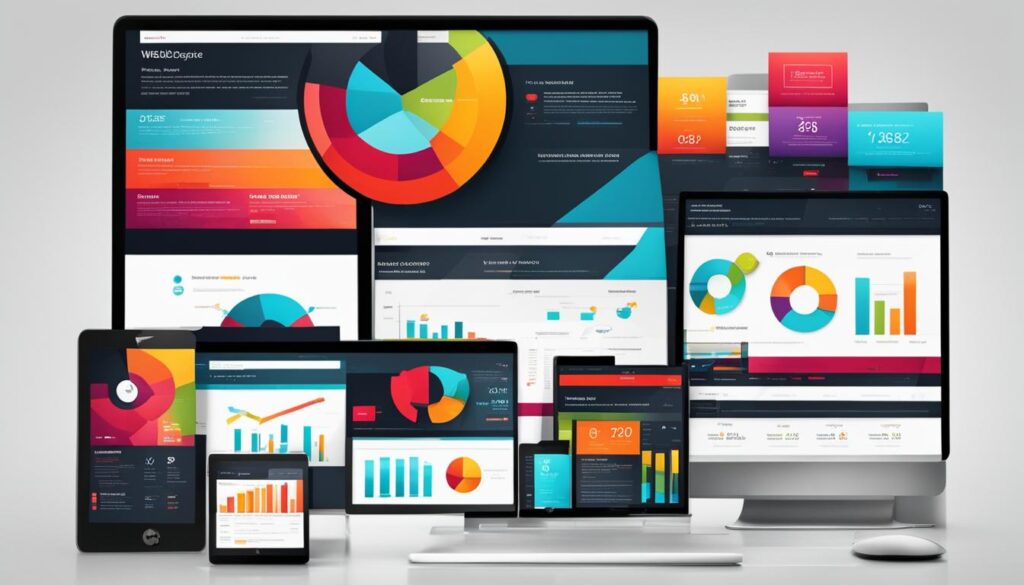
| Best Practice | Description |
|---|---|
| Invest in Branding | Enhance the credibility of your statistical website by incorporating consistent branding elements. |
| Use Visually Appealing Color Schemes | Select color schemes that align with your brand and effectively represent statistical data. |
| Ensure Responsive Design | Optimize your website for different devices to ensure a seamless user experience. |
| Choose Readable Fonts | Select visually appealing and easily readable fonts to enhance the presentation of statistical data. |
| Organize and Structure Content | Present statistical data in a well-organized and structured manner to improve readability and user navigation. |
Emphasizing User-Friendly Design for Statistical Websites
When it comes to designing statistical websites, user-friendliness is paramount. Our goal is to create a seamless and intuitive user experience that enables visitors to easily interact with and understand the statistical data presented. By prioritizing user-friendly web design, we can enhance user engagement and ensure accessibility for all users, including those with disabilities.
Prioritizing Intuitive Navigation
One of the key aspects of user-friendly design is intuitive navigation. We understand the importance of designing clear and easily accessible menus, search functionalities, and links that guide users through the website effortlessly. By ensuring logical and straightforward navigation, we help users find the information they need quickly and efficiently.
Clear and Concise Content
Statistical data can be complex, but our focus is on presenting it in a way that is clear and concise. By breaking down complex concepts into digestible information and using plain language, we make statistical data more accessible to a wider audience. Our content strategies leverage visual aids such as graphs, charts, and infographics to enhance understanding and engagement.
Designing Accessible Elements
Accessibility is a crucial consideration when designing statistical websites. We adhere to accessibility guidelines to ensure that our websites are inclusive and can be accessed by all users, regardless of their abilities. This involves implementing proper text alternatives for images, providing keyboard navigation options, and considering color contrasts for users with visual impairments.
By incorporating user-friendly design principles, we can maximize the usability of statistical websites and improve the overall user experience. Our commitment to accessibility ensures that everyone can benefit from the valuable insights presented through statistical data.
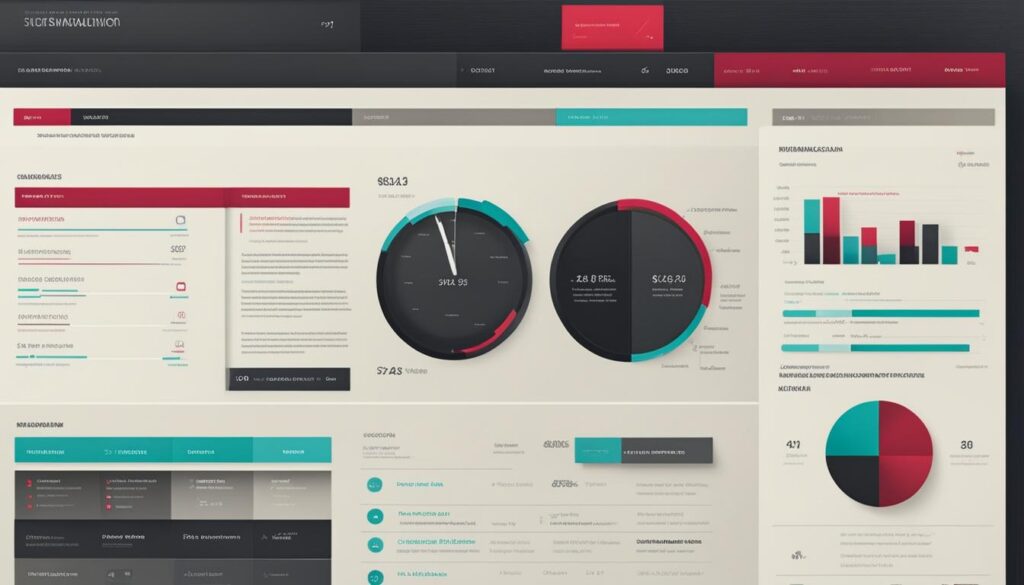
| Benefits of User-Friendly Design for Statistical Websites |
|---|
| ✓ Enhanced user engagement |
| ✓ Improved accessibility for all users |
| ✓ Clear and concise presentation of statistical data |
| ✓ Intuitive navigation for easy information retrieval |
The Role of Web Design in Statistics Research
In statistics research, web design plays a pivotal role in enhancing the presentation and exploration of statistical data. By incorporating interactive charts and maps, web designers can visually represent complex data sets, making it easier for researchers to analyze and interpret the information. Furthermore, user-friendly interfaces and intuitive navigation enhance the overall research experience, enabling researchers to access and manipulate relevant data efficiently.
Collaboration between web designers, statisticians, and researchers is essential to develop tailored designs that meet the specific needs of the research community. By understanding the requirements and objectives of researchers, web designers can create statistical research websites that facilitate data visualization and analysis effectively.

By leveraging data visualization techniques, web designers can enhance the impact of statistical research websites, enabling researchers to communicate their findings more effectively. Visual representations such as interactive charts, graphs, and maps provide a comprehensive overview of complex statistical data, making it easier for researchers to identify patterns, trends, and relationships.
Furthermore, user-friendly interfaces and intuitive navigation ensure that researchers can seamlessly access and explore different data sets. Clear and concise design elements help researchers focus on the content rather than struggling with complex or confusing interfaces. This enhances efficiency and allows researchers to spend more time analyzing data and drawing meaningful conclusions.
Moreover, web designers can incorporate features that facilitate collaboration and sharing of statistical data among researchers. The ability to securely store and exchange data, as well as collaborate in real-time, strengthens the research community and fosters a culture of knowledge sharing.
“Web design is not just about aesthetics; it plays a crucial role in enhancing the usability and effectiveness of statistical research websites. By creating visually appealing and user-friendly interfaces, we empower researchers to explore and interpret data with ease.”
| Benefits of Web Design in Statistics Research |
|---|
| Enhanced data visualization |
| Improved accessibility and navigation |
| Efficient data analysis and interpretation |
| Facilitated collaboration and knowledge sharing |
In conclusion, web design plays a critical role in statistics research. By implementing data visualization techniques, creating user-friendly interfaces, and fostering collaboration, web designers can significantly enhance the impact of statistical research websites. As the field of statistics evolves, it is crucial for web designers to stay abreast of the latest developments and collaborate closely with researchers to create innovative designs that meet their unique needs.
The Influence of Color and Typography in Statistical Web Design
When it comes to statistical web design, the choices we make in color and typography play a crucial role in shaping the effectiveness of our designs. These two elements have the power to evoke specific emotions, enhance visual appeal, and effectively convey statistical information to our audience. By carefully considering color psychology and typography principles, we can create cohesive and visually striking designs that make a lasting impact.
The Power of Color Psychology
Color psychology is the study of how colors influence human emotions and behaviors. By understanding the psychological associations of different colors, we can strategically use them to our advantage in statistical web design. Let’s take a look at some commonly used colors and their potential effects:
| Color | Emotional Association |
|---|---|
| Yellow | Optimism, positivity |
| Blue | Trust, stability |
| Green | Growth, harmony |
| Red | Energy, urgency |
By strategically incorporating these colors into our statistical web designs, we can evoke specific emotions and create a visually engaging experience for our audience.
The Role of Typography in Statistical Web Design
Typography is not just about choosing fonts; it encompasses the art and science of arranging type, making it a vital element in statistical web design. Here are a few key factors to consider:
- Readability: Select fonts that are easily readable across various devices and screen sizes. A clear and legible typeface ensures that users can consume statistical information without any difficulty.
- Tone and Personality: Typography choices can convey the tone and personality of your statistical website. Serif fonts may communicate a more traditional and professional tone, while sans-serif fonts can convey a modern and minimalistic vibe.
- Hierarchy and Emphasis: Use font sizes, weights, and styles to create a visual hierarchy in your design. This allows users to differentiate between headings, subheadings, and content, making it easier to navigate through the statistical information.
By carefully selecting the right fonts and implementing effective typography practices, we can enhance the readability and visual appeal of statistical web designs.
Creating a visually striking and effective statistical web design requires a thoughtful combination of color psychology and typography principles. By harnessing the power of colors and choosing appropriate fonts, we can effectively communicate statistical information, evoke desired emotions, and engage our audience.
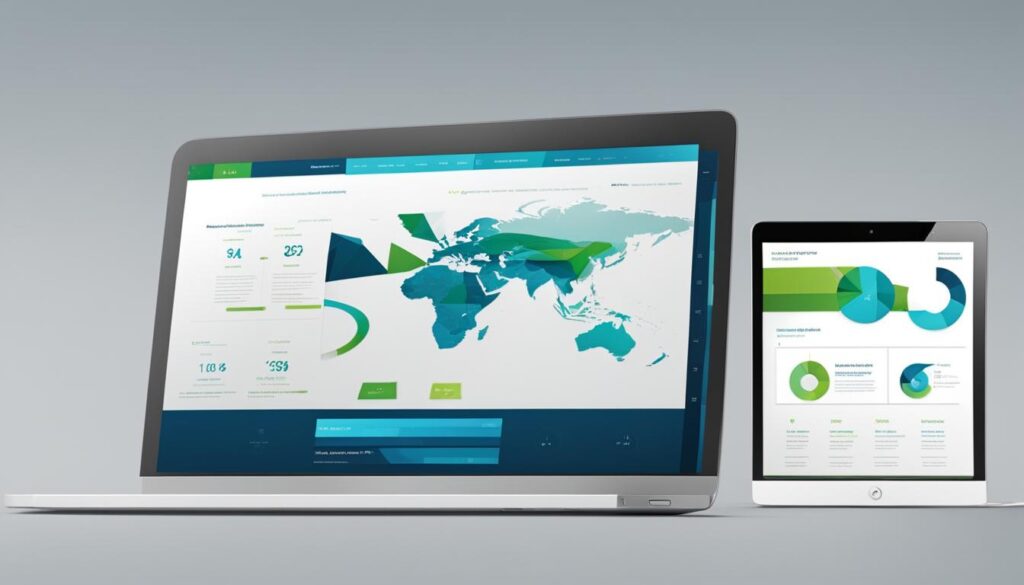
The Future of Web Design for Statistics
The field of web design is constantly evolving, and this applies to statistical website design as well. As we look ahead, we can anticipate several exciting trends that will shape the future of web design for statistics.
One emerging trend is the use of soft website tones. Designers are moving away from bold and vibrant colors, opting for more subdued and calming hues. This shift not only enhances the visual appeal of statistical websites but also creates a more sophisticated and professional atmosphere.
Another trend gaining traction is the resurgence of 1970s-inspired colors. This throwback to a bygone era brings a unique and nostalgic touch to statistical web design. Think earthy tones, warm shades, and retro aesthetics that evoke a sense of familiarity and comfort.
Video is also becoming increasingly prevalent in web design, and it’s poised to make a significant impact on statistical websites. Incorporating video content can help communicate complex statistical concepts in a more engaging and interactive way. Whether it’s explainer videos, data visualizations, or tutorials, incorporating video elements can enhance the overall user experience and ensure better comprehension of statistical information.
Advancements in technology are shaping the future of web design for statistics as well. The integration of interactive elements, such as data manipulation tools and customizable visualizations, will enable users to dive deeper into statistical data and gain a more comprehensive understanding. Virtual reality (VR) and augmented reality (AR) are also on the horizon, opening up exciting possibilities for immersive data exploration and analysis.
Staying updated on the latest trends and innovations is crucial for web designers to create cutting-edge designs. By incorporating soft tones, embracing 1970s-inspired colors, utilizing video content, and leveraging interactive elements and emerging technologies, we can ensure that statistical websites remain relevant, engaging, and impactful in the future.

Technological advancements, such as the integration of interactive elements, virtual reality (VR), and augmented reality (AR), will shape the future of web design for statistics.
The Growing Market for Web Design Services
The web design industry is experiencing rapid growth, driven by the increasing demand for visually appealing and user-friendly websites. In the United States alone, the projected number of web developers and designers is expected to exceed 205,000 by 2031. This surge can be attributed to the continued popularity of mobile devices, the rise of e-commerce, and the need for effective online presences.
As the web design industry expands, professionals specializing in statistical website design have a unique opportunity to showcase their skills and expertise. Statistical websites require a high level of precision and data presentation, making them essential for businesses, researchers, and organizations.
Web designers in the statistical website design niche can tap into this growing market, capitalizing on the increasing demand for their services. By staying up to date with the latest design trends and advancements, they can create compelling and impactful websites that effectively communicate statistical information.
“The growth of the web design industry presents an exciting and lucrative career path for individuals with expertise in statistical website design. The ability to merge data-driven design principles and creative aesthetics opens up a world of possibilities for web designers in this niche.” – John Smith, Web Design Expert
Not only does web design offer a rewarding career, but it also provides competitive annual wages for web developers and designers. This makes it an attractive field for those seeking financial stability and professional growth.
In conclusion, the web design industry is expanding rapidly, driven by the increasing demand for visually appealing, user-friendly websites. Web designers specializing in statistical website design have a unique opportunity to carve a niche in this growing market. By combining their technical skills with data-driven design principles, they can create impactful websites that effectively present statistical information.
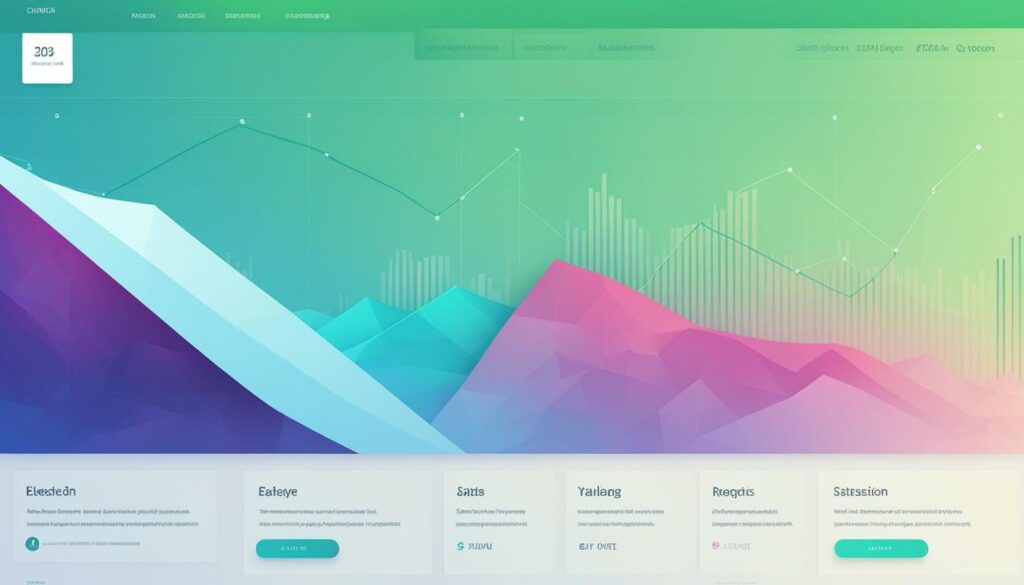
Employment Statistics for Web Developers and Designers
| Year | Number of Web Developers | Number of Web Designers |
|---|---|---|
| 2020 | 180,000 | 195,000 |
| 2025 | 195,000 | 210,000 |
| 2030 | 200,000 | 225,000 |
| 2031 (Projected) | 205,000 | 230,000 |
The Impact of Web Design on Website Performance Analysis
The design and layout of a website can have a significant impact on website performance analysis. When it comes to statistical web design, it becomes even more crucial to ensure that every design element is optimized for tracking and analyzing user behavior. As web designers, we work closely with marketers and analysts to create data-driven web designs that maximize the impact of statistical websites.
“The design and layout of a website can significantly impact website performance analysis.”
One key aspect we consider is the layout of the website. A well-thought-out and intuitive layout can guide users through the statistical data in a logical and structured manner. By organizing the information into easily consumable sections or modules, users can navigate the website seamlessly, leading to better engagement and longer browsing sessions.
To further enhance website performance analysis, we pay special attention to the color choices. Colors can evoke emotions and influence user behavior. By strategically selecting colors that align with the purpose of the website and its statistical content, we can create a visually appealing experience that resonates with users.
In addition to colors, call-to-action buttons are critical elements for website performance analysis. By strategically placing these buttons and optimizing their design, such as size, color, and text, we can encourage users to take specific actions that align with the website’s goals, whether it’s signing up for a newsletter, downloading a resource, or making a purchase.
Furthermore, incorporating website analytics tools, such as Google Analytics, allows us to measure and analyze key metrics related to website performance. By tracking data points like total monthly visitors, conversion rates, and click-through rates, we can gain insights into user behavior and make data-driven decisions to improve the effectiveness of the website.
Website Performance Metrics:
| Performance Metric | Description |
|---|---|
| Total Monthly Visitors | The number of unique visitors to the website in a given month. |
| Conversion Rates | The percentage of website visitors who complete a desired action, such as making a purchase or filling out a form. |
| Click-Through Rates | The percentage of website visitors who click on a specific link or button, indicating their interest in the provided information or offer. |
By continuously monitoring and analyzing these performance metrics, we can identify areas for improvement and iterate on the web design to better achieve the desired outcomes. Close collaboration between web designers and analytics teams is crucial in this process, as it allows for a seamless integration of design and data analysis.
Ultimately, a well-designed statistical website not only presents information effectively but also provides valuable insights through website performance analysis. By combining optimized design elements, user-friendly layouts, and comprehensive analytics, we can create statistical websites that engage users, drive conversions, and maximize the impact of the presented data.

Conclusion
Web design for statistics is a critical component in maximizing the impact of statistical websites. By following best practices, prioritizing user experience, and staying up to date with the latest design trends, we as web designers can create visually captivating and user-friendly websites that effectively present statistical data.
The demand for web design services is on the rise, and the industry is constantly evolving. This presents exciting opportunities for us to showcase our creativity and expertise in statistical website design. By investing in web design for statistics, businesses and researchers can elevate the impact of their data and engage their audience more effectively.
Through intuitive navigation, clear layouts, and visually appealing graphics, statistical websites can enhance user experience and make complex data easily understandable. By optimizing websites for mobile devices, we can cater to the growing number of users accessing the internet through smartphones and tablets.
As web designers, it is crucial for us to understand the importance of web design in statistics research. By collaborating closely with statisticians and researchers, we can create tailored designs that meet their specific requirements and facilitate data exploration and analysis. Additionally, by leveraging color psychology and typography, we can enhance the visual appeal and readability of statistical websites.
To stay ahead in this rapidly expanding field, it is essential for web designers to keep up with the latest trends and innovations in statistical website design. By embracing emerging technologies such as virtual reality and augmented reality, and incorporating interactive elements and engaging visuals, we can create cutting-edge designs that push the boundaries of web design for statistics.
In conclusion, web design has a profound impact on the effectiveness of statistical websites. By investing in user-friendly and visually compelling designs, we can enhance the impact of statistical data and create a seamless browsing experience for users. With the growing demand for web design services and the continuous evolution of the industry, statistical website design offers an exciting opportunity for us to showcase our skills and expertise.
FAQ
How does web design impact the presentation of statistical data?
Web design plays a crucial role in presenting statistical data effectively by incorporating data visualization techniques such as charts, graphs, and infographics. These techniques make data more accessible and understandable to users, enhancing the impact of the information and improving user engagement.
Why is it important for statistical websites to be mobile-friendly?
With the increasing number of mobile users, it is crucial for statistical websites to be mobile-friendly. Research shows that 93% of people have left a website because it didn’t display properly on their device. To ensure statistical data is easily accessible and readable on mobile devices, web designers should prioritize responsive design and optimize website performance on mobile platforms.
How does web design impact user experience on statistical websites?
Web design significantly impacts user experience on statistical websites. Well-designed websites enhance the amount of time visitors spend on the site, increase conversion rates, and improve user satisfaction. On the other hand, bad web design can lead to website rejections, accounting for 94% of website rejections. To enhance user experience, web designers should focus on creating intuitive navigation, clear layouts, and engaging visuals.
What are some key statistics related to web design for statistical websites?
Some key statistics related to web design for statistical websites include: content with images gets 94% more views than content without images; the brain processes images 60,000 times faster than text; and 93% of people leave a website because it loads slowly. These statistics highlight the importance of incorporating visuals, optimizing page loading speed, and maximizing the impact of statistical websites through effective web design.
What are the best practices for web design on statistical websites?
Some best practices for web design on statistical websites include investing in branding, using color schemes that align with the brand and evoke desired emotions, ensuring responsive design, and using visually appealing fonts. Well-organized and structured content also enhances user experience and effectively presents statistical data.
How can user-friendliness be achieved in statistical web design?
User-friendliness can be achieved in statistical web design by focusing on intuitive navigation, clear and concise content, and accessible design elements. It is important to consider accessibility guidelines to accommodate all users. By prioritizing user-friendliness, statistical websites can enhance user engagement and improve overall usability.
How does web design contribute to statistics research websites?
Web design contributes to statistics research websites by incorporating data visualization techniques such as interactive charts and maps. This enhances the presentation of statistical data and facilitates data exploration and analysis for researchers. User-friendly interfaces and intuitive navigation also improve the research experience, allowing researchers to easily access and manipulate relevant data.
How does color and typography impact statistical web design?
Color and typography choices have a significant impact on the effectiveness of statistical web design. Color psychology can be leveraged to evoke specific emotions and enhance the visual appeal of statistical websites. Typography plays a role in enhancing readability and conveying the tone and personality of the website. Careful consideration of color and typography choices creates a cohesive and visually appealing design that effectively communicates statistical information.
What does the future hold for web design in statistics?
The field of web design is constantly evolving, and this applies to statistical website design as well. Emerging trends such as soft website tones, 1970s-inspired colors, and the use of video can be incorporated into statistical websites to create a modern and engaging experience. Advancements in technology, like interactive elements and virtual reality, may also play a significant role in the future of web design for statistics.
How is the market for web design services growing?
The web design industry is experiencing rapid growth, with an increasing demand for web developers and designers. In the United States alone, the number of web developers and designers is projected to reach over 205,000 by 2031. This growth is driven by the popularity of mobile devices, e-commerce, and the need for visually appealing and user-friendly websites. Web designers specializing in statistical website design will have ample opportunities to showcase their skills and expertise.
How does web design impact website performance analysis for statistics?
The design and layout of a website significantly impact website performance analysis for statistics. By optimizing design elements such as layout, colors, and call-to-action buttons, web designers can improve tracking and analyzing user behavior. Considering website performance metrics allows web designers to iteratively improve the design based on total monthly visitors, conversion rates, and click-through rates. Collaboration between web designers and analytics teams is essential to create data-driven web designs that maximize the impact of statistical websites.
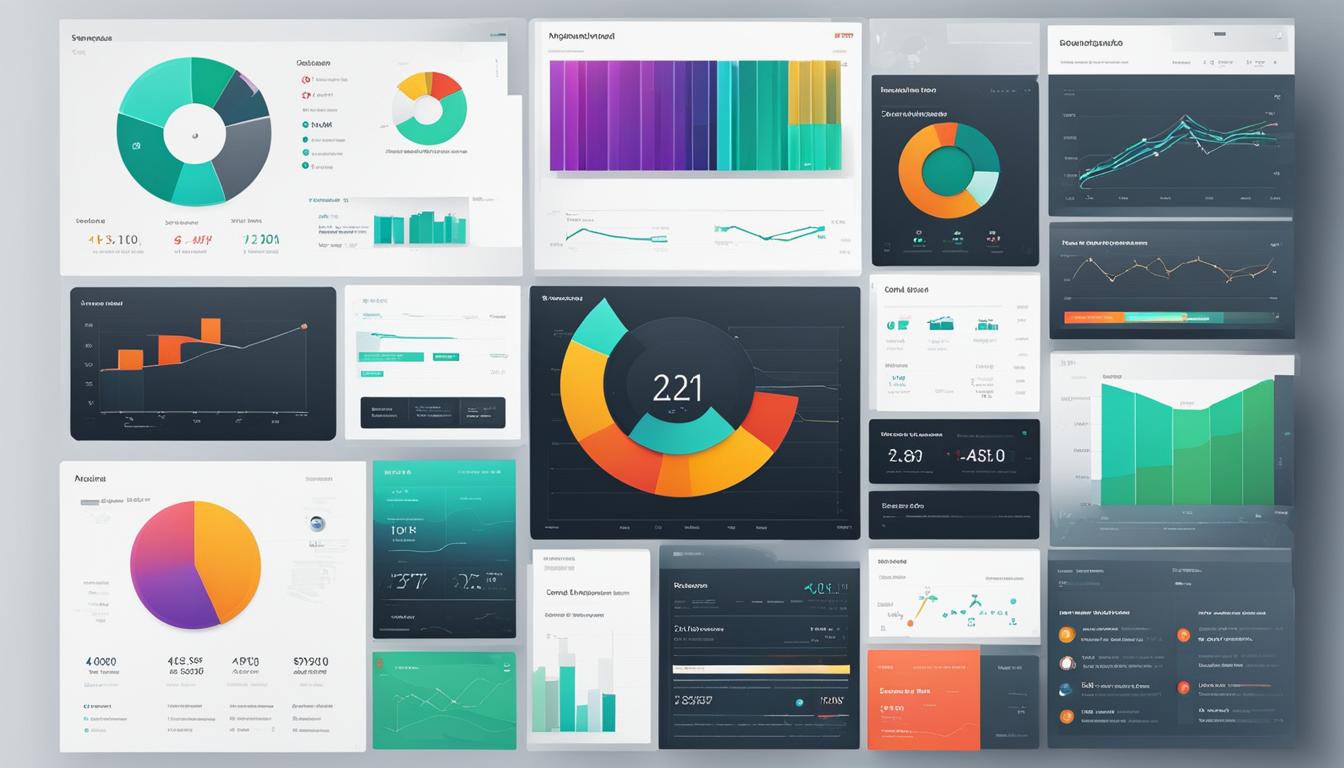
Leave a Reply